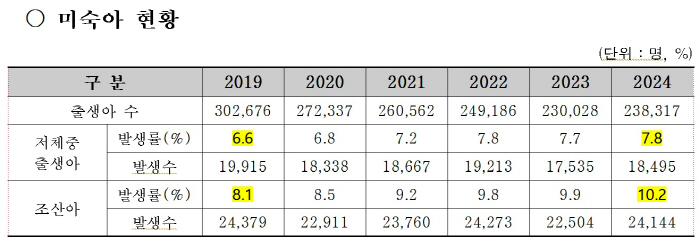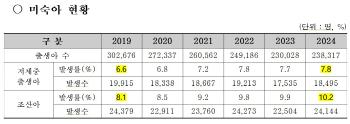The number of premature babies and congenital abnormalities is increasing, and the number of pediatric and adolescent doctors ↓
Oct 09, 2025
|
|
According to Rep. Seo Mi-hwa (Democratic Party of Korea), a member of the National Assembly's Health and Welfare Committee, received from the Ministry of Health and Welfare, the number of congenital abnormalities or abnormalities in the last six years increased by 4.5 percentage points from 27.6% in 2019 to 32.1% in 2023. During the same period, the proportion of premature babies increased by 2.1 percentage points from 8.1 percent to 10.2 percent, and the incidence of underweight births steadily increased from 6.6% in 2019 to 7.8% in 2024.
The Ministry of Health and Welfare believes that the cause of premature babies is ▲an increase in the average birth age ▲ an increase in mothers aged 35 or older ▲ an increase in multiple births. In 2024, the average age of childbirth increased by 0.7 years compared to 2019, and the proportion of mothers aged 35 or older increased by 2.5 percentage points from 33.4% to 35.9%. In addition, the proportion of multiple births also increased by 1.2 percentage points from 4.6% to 5.7%.
It has been confirmed that the number of hospitalizations in the neonatal intensive care unit has not decreased due to the increase in the proportion of premature babies and congenital abnormal babies despite the decreasing trend of newborns. Over the past five years, it has exceeded 460,000 cases every year, except for a slight decrease to 440,000 in 2023.
Despite the increasing proportion of premature and congenital abnormal children, the number of neonatal intensive care unit installation institutions and doctors working at the institution is decreasing. The number of pediatric and adolescent doctors working in the neonatal intensive care unit installation institution, including residents and specialists, was 534, but decreased by 31.3% to 367 in 2025. During the same period, the number of institutions installing neonatal intensive care units also decreased by three from 92 to 89.
While the number of pediatric and adolescent medical staff is decreasing, the number of people supporting pediatric and adolescent departments is also decreasing. In the first half of 2020, 152 people were selected to fill 71% of the total capacity, but in 2021 it was significantly reduced to 78 (36.8% of capacity), and in 2025 it was only 27 (13.6% of capacity). Even with the exception of 2024, when the legislative conflict was at its peak, the Department of Pediatrics and Adolescents suffers from a shortage of manpower every year.
Rep. Seo Mi-hwa said, "In Korea, which has the lowest birth rate among OECD countries, the reality of fewer medical personnel and facilities to protect the lives and health of children is another national crisis. The government should no longer leave the treatment gap for premature babies and congenital abnormal babies due to the delayed birth age." In order to increase the rate of application for pediatric and adolescent departments that decrease every year, the government should take measures at the national level, including related support such as improving treatment for pediatric and adolescent departments and expanding training compensation, he stressed.
This article was translated by Naver AI translator.














